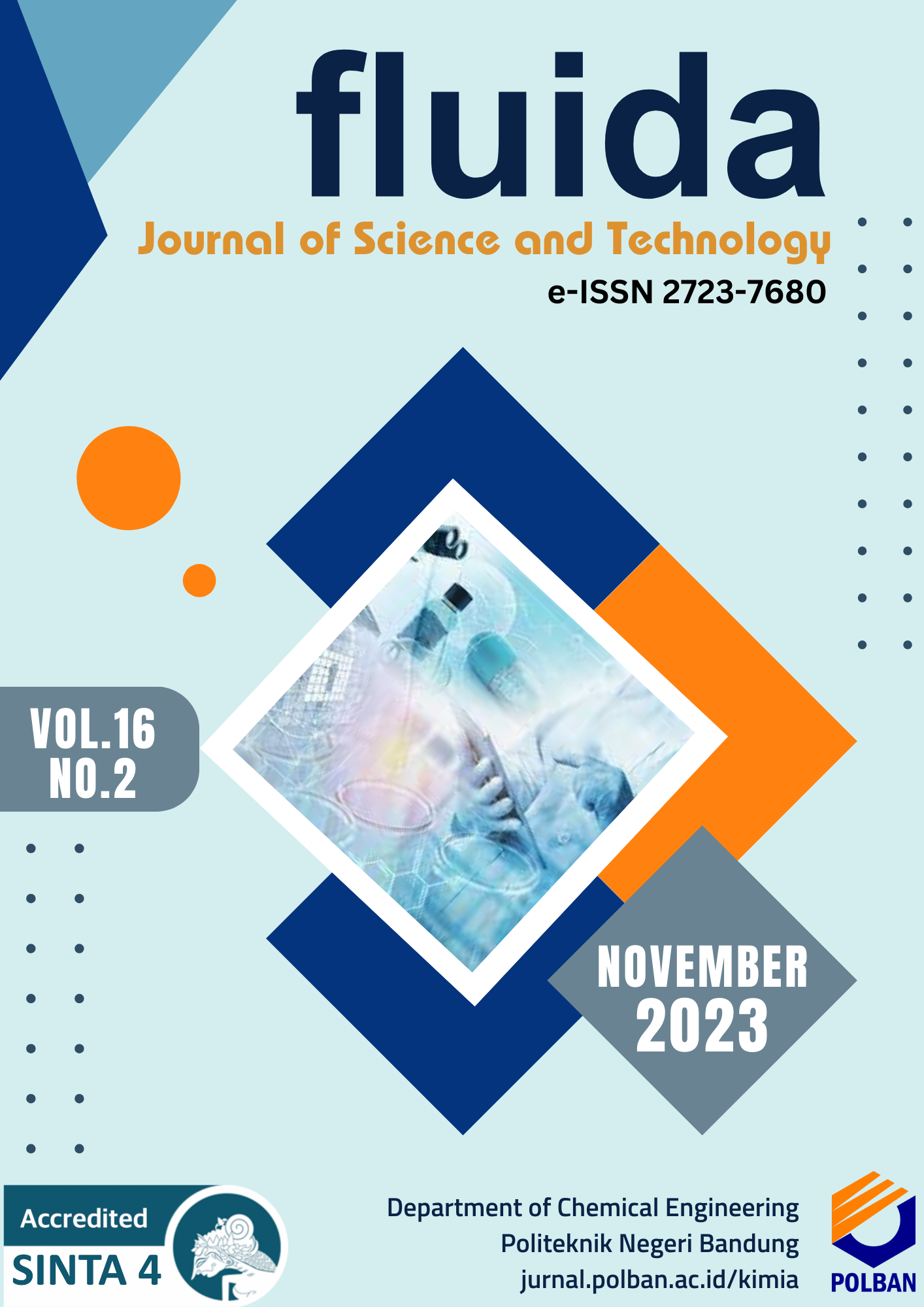Biogasoline Production from Shallot Skin Waste with KOH-Clay Catalyst to Create Clean Energy
Main Article Content
Abstract
Finding alternative fuels to replace fossil fuels has been made easier by the rise in the consumption of fuels like petrol and the fall in the production of national petroleum exploration activities. This research has been prompted using biomass as an alternative fuel. The primary raw material is shallot skin waste because it has enough lignocellulosic content to be used, one of which is to manufacture biogasoline by using the characteristics of petrol E10. A KOH-Clay catalyst is employed in a thermal and catalytic reaction to influence the reaction's pace. Starting with raw material preparation, conversion procedure, purification, and investigation of the physical properties of biogasoline at specific temperature fluctuations for an hour, the KOH-Clay catalyst is pretreated and characterised. It was discovered through this research that the montmorillonite KOH-Clay content was 5.73, indicating that the catalyst is hygroscopic and absorbs non-polar molecules, making it suitable for use as a catalyst with a pH of 6. As a result, at 60°C temperature circumstances, the best%yield results were attained of 35.025%. While the density value (0.950 gr/cm3) and colour (specific gravity, brownish yellow, and clear/bright) of the experimental results do not meet predetermined standards, they do when viewed from the viewpoint of physical parameters such as specific gravity (0.8358), oAPI biogasoline (37.794), and calorific value (18807.65 Btu/Ib). However, leftover shallot peels generally have the potential to be utilised as clean renewable energy.
Downloads
Article Details

This work is licensed under a Creative Commons Attribution-ShareAlike 4.0 International License.
An author who publishes in the FLUIDA journal agrees to the following terms:
- Author retains the copyright and grants the journal the right of first publication of the work simultaneously licensed under the Creative Commons Attribution-ShareAlike 4.0 License that allows others to share the work with an acknowledgement of the work's authorship and initial publication in this journal
- Author is able to enter into separate, additional contractual arrangements for the non-exclusive distribution of the journal's published version of the work (e.g., post it to an institutional repository or publish it in a book) with the acknowledgement of its initial publication in this journal.
- Author is permitted and encouraged to post his/her work online (e.g., in institutional repositories or on their website) prior to and during the submission process, as it can lead to productive exchanges, as well as earlier and greater citation of the published work (See The Effect of Open Access).
Read more about the Creative Commons Attribution-ShareAlike 4.0 Licence here: https://creativecommons.org/licenses/by-sa/4.0/.
References
and B, “Pengaruh Temperatur dan
Katalis Lempung Aktif Pada
Pengolahan Sampah Plastik Jenis
Polypropylene dengan Metode
Pirolisis,” Tek. Kim. Fak. Tek. Univ.
Riau, pp. 1–7, 2014.
[2] T. Retnaningsih, “Sintesis dan
karakterisasi zeolit hierarki
terimpreg Ni-Mo untuk catalytic
cracking minyak jarak pagar
(Jatropha curcas L.),” Skripsi, pp. 1–
7
67, 2020, [Online]. Available:
http://repository.uinjkt.ac.id/dspac
e/handle/123456789/53171%0Ahttp
://repository.uinjkt.ac.id/dspace/bit
stream/123456789/53171/1/TRI
RETNANINGSIH-FST.pdf
[3] Sherty Amelia, “Karakterisasi
Lempung Alam Cengar Aktivasi KOH
Pada 300C,” Jom Fmipa, vol. 1, no. 2,
pp. 1–9, 2014.
[4] Sukmasari Antaria, “Studi
Penggunaan Zeolit Alam Sulawesi
Selatan,” pp. 39–43, 2015.
[5] Indrasukma Permanadewi, Andri
Cahyo Kumoro, Dyah Hesti
Wardhani, and Nita Aryanti,
“Analysis of Temperature
Regulation, Concentration, and
Stirring Time at Atmospheric
Pressure to Increase Density
Precision of Alginate Solution,”
Teknik, vol. 42, no. 1, pp. 29–34,
2021, doi:
10.14710/teknik.v42i1.35994.
[6] Ariansyah Trisa, Wahidin Nuriana,
and Mustafa, “Pengaruh Variasi
Tekanan Terhadap Densitas , Kadar
Air Dan Laju Pembakaran Pada
Briket Pelepah Kelapa,” Semin. Nas.
Sains dan Teknol. Terap. VII, vol. 7,
p. 422, 2019.
[7] Arizal Aswan et al., “PENGOLAHAN
PLASTIK POLYSTYRENE DAN
POLYPROPYLENE MENJADI
LIQUID FUEL MENGGGUNAKAN
KATALIS GAMMA ALUMINA (?-
Al2O3) DAN ZEOLIT TERAKTIVASI
DALAM SINGLE STAGE
SEPARATOR,” Publ. Penelit. Terap.
dan Kebijak., vol. 4, no. 2, pp. 65–73,
2021, doi: 10.46774/pptk.v4i2.393.
[8] I. Wiratmaja, “Pengujian
karakteristik fisika biogasoline
sebagai bahan bakar alternatif
pengganti bensin murni,” J. Energi
Dan Manufaktur, vol. 4, no. 2, pp.
148–154, 2014.
[9] Bayu Wiyantoko, “Modul Kuliah
Kimia Petroleum,” Jur. Anal. Kim.
FMIPA, Univ. Islam Indones., pp. 1–
63, 2016, [Online]. Available:
https://www.ptonline.com/articles/
how-to-get-better-mfi-results
[10] Daud Patabang, “Analisis nilai kalor
secara eksperimental dan teoritik
dari briket arang kulit kemiri,” no. 2,
2009.
[11] Trirakhma Sofihidayati,
“PENETAPAN KADAR FLAVONOID
DAN AKTIVITAS ANTIMIKROBA
EKSTRAK ETANOL KULIT
BAWANG MERAH (Allium cepa L.)
TERHADAP Staphylococcus aureus,”
FITOFARMAKA J. Ilm. Farm., vol. 8,
no. 2, pp. 99–104, 2018, doi:
10.33751/jf.v8i2.1573.

